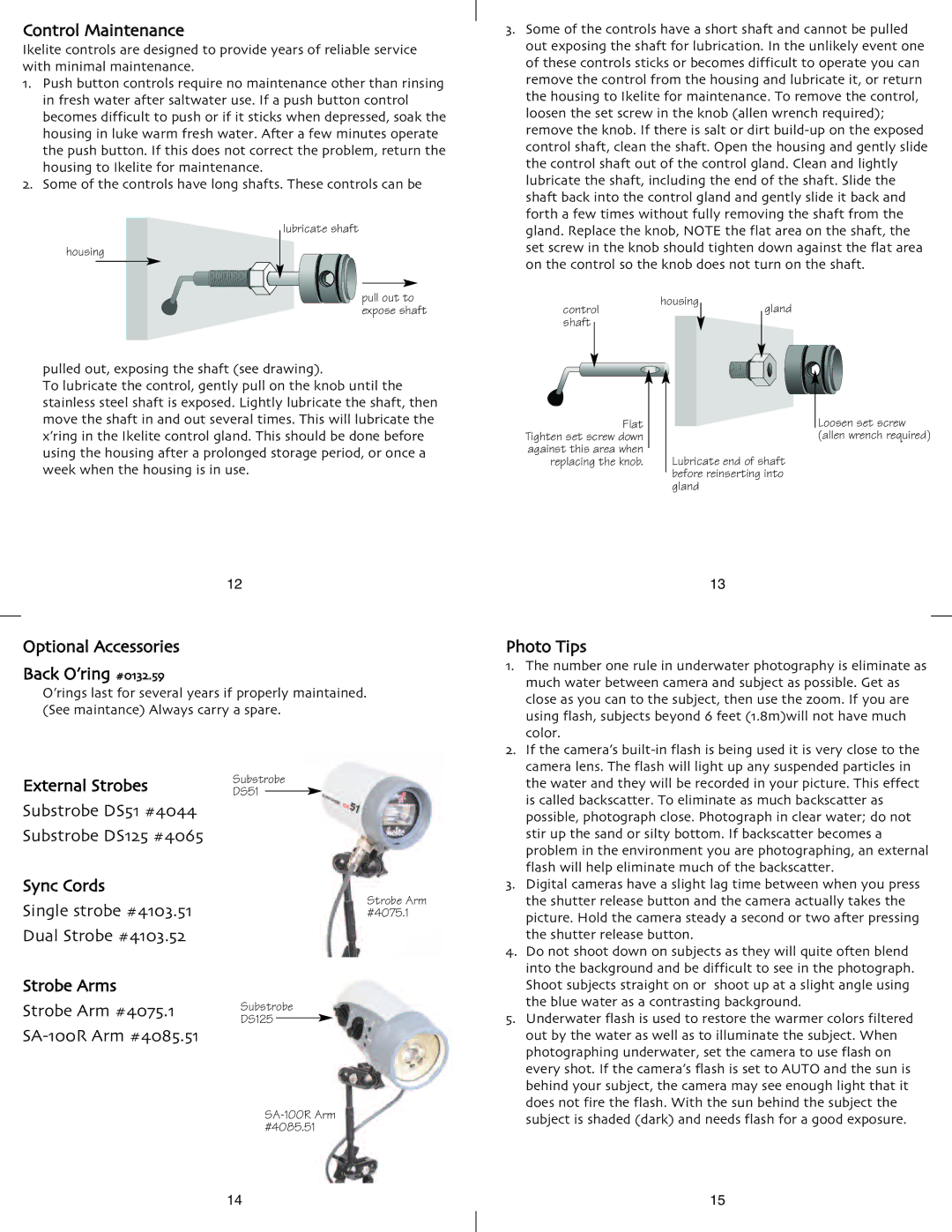
Control Maintenance
Ikelite controls are designed to provide years of reliable service with minimal maintenance.
1. Push button controls require no maintenance other than rinsing in fresh water after saltwater use. If a push button control becomes difficult to push or if it sticks when depressed, soak the housing in luke warm fresh water. After a few minutes operate the push button. If this does not correct the problem, return the housing to Ikelite for maintenance.
2. Some of the controls have long shafts. These controls can be
lubricate shaft
housing
3.Some of the controls have a short shaft and cannot be pulled out exposing the shaft for lubrication. In the unlikely event one of these controls sticks or becomes difficult to operate you can remove the control from the housing and lubricate it, or return the housing to Ikelite for maintenance. To remove the control, loosen the set screw in the knob (allen wrench required); remove the knob. If there is salt or dirt
pull out to expose shaft
pulled out, exposing the shaft (see drawing).
To lubricate the control, gently pull on the knob until the stainless steel shaft is exposed. Lightly lubricate the shaft, then move the shaft in and out several times. This will lubricate the x’ring in the Ikelite control gland. This should be done before using the housing after a prolonged storage period, or once a week when the housing is in use.
control | housing |
|
| gland | |
| |||||
shaft |
|
|
|
|
|
|
|
|
|
|
|
|
|
|
|
|
|
Flat Tighten set screw down against this area when
replacing the knob. Lubricate end of shaft before reinserting into gland
Loosen set screw (allen wrench required)
12
Optional Accessories
Back O’ring #0132.59
O’rings last for several years if properly maintained. (See maintance) Always carry a spare.
External Strobes | DS51 | ||||
Substrobe DS51 #4044 | Substrobe | ||||
|
|
|
|
| |
Substrobe DS125 #4065 |
|
|
|
|
|
Sync Cords |
|
|
|
| Strobe Arm |
Single strobe #4103.51 | #4075.1 | ||||
Dual Strobe #4103.52 |
|
|
|
|
|
Strobe Arms | DS125 | ||||
Strobe Arm #4075.1 | |||||
Substrobe | |||||
|
|
|
|
| |
13
Photo Tips
1. The number one rule in underwater photography is eliminate as much water between camera and subject as possible. Get as close as you can to the subject, then use the zoom. If you are using flash, subjects beyond 6 feet (1.8m)will not have much color.
2. If the camera’s
3. Digital cameras have a slight lag time between when you press the shutter release button and the camera actually takes the picture. Hold the camera steady a second or two after pressing the shutter release button.
4. Do not shoot down on subjects as they will quite often blend into the background and be difficult to see in the photograph. Shoot subjects straight on or shoot up at a slight angle using the blue water as a contrasting background.
5. Underwater flash is used to restore the warmer colors filtered out by the water as well as to illuminate the subject. When photographing underwater, set the camera to use flash on every shot. If the camera’s flash is set to AUTO and the sun is behind your subject, the camera may see enough light that it does not fire the flash. With the sun behind the subject the subject is shaded (dark) and needs flash for a good exposure.
14 | 15 |
